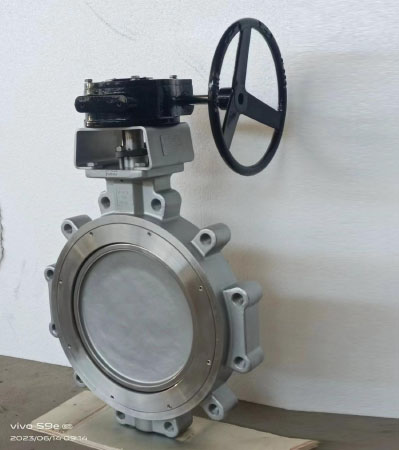High-performance butterfly valves are critical components in solvent plants, where they must handle corrosive, flammable, and often toxic substances. These valves are designed to provide reliable sealing, prevent leaks, and ensure safe and efficient operations. This article explores the key applications, technical advantages, and selection criteria for these essential valves.
Key Advantages in Solvent Plants:
- Chemical Corrosion Resistance:
- Valve bodies and sealing materials (PTFE lining, Hastelloy, 316L stainless steel) withstand strong acids, alkalis, and organic solvents (acetone, toluene, chloroform).
- Zero-Leakage Sealing:
- Multi-layered soft or metal hard seals prevent volatile solvent leaks, especially for hazardous media.
- Explosion-Proof and Safety:
- Pneumatic or electric explosion-proof actuators meet safety requirements in hazardous areas (Ex d IIB T4).
- Rapid Response:
- Automated control (PLC interlocking) enables quick pipeline shut-off in emergencies.
- Complex Operating Conditions:
- High temperature (-50°C to 200°C) and pressure (PN16-PN40) resistance for solvent distillation and pressurized reactions.
Typical Applications:
- Solvent Storage and Transfer:
- Tank inlet/outlet control to regulate flow and prevent overpressure.
- Pipeline switching to isolate and transfer different solvents.
- Reaction Vessels and Mixing:
- Precise dosing of solvents, catalysts, and reactants.
- Jacket circulation control for stable reaction temperatures.
- Solvent Recovery and Distillation:
- Corrosion-resistant valves control solvent vapor flow in distillation towers.
- Condenser inlet/outlet control for thermal load balancing.
- Hazardous Media Safety:
- Emergency shut-off systems linked to gas detectors.
- Nitrogen blanketing to prevent solvent volatilization or oxidation.
- Wastewater and Waste Gas Treatment:
- Solvent recovery in wastewater pre-treatment.
- High-temperature valves for waste gas flow control in incinerators.

Selection and Design Criteria:
- Material Selection:
- Stainless steel (316L, 904L) for general solvents.
- Hastelloy (C276) or titanium for strong corrosives.
- PTFE/PFA lining for strong acids, alkalis, and polar solvents.
- PTFE or PCTFE for optimal chemical resistance.
- FFKM for high temperatures(200°C plus) and mixed solvent resistance.
- Structural Design:
- Double or Triple offset metal seals for high-temperature, high-pressure, and frequent cycling.
- Full bore design to prevent residue buildup.
- Fire-safe design (API 607/API 6FA).
- Actuation:
- Pneumatic (explosion-proof) for flammable environments.
- Electric (IP67) with Modbus or Profibus integration.
- Manual with gear operators for non-hazardous areas.
Comparison with Other Valves:
- Ball Valves:
- Butterfly valves are lower cost (especially large diameters), but ball valves offer better high-pressure sealing.
- Diaphragm Valves:
- Butterfly valves handle higher pressures, while diaphragm valves are suitable for ultra-pure solvents.
Maintenance and Failure Prevention:
- Regular Inspections:
- Seal wear, stem lubrication.
- Cleaning and Corrosion Protection:
- Nitrogen purging, compatible cleaning agents.
- Intelligent Monitoring:
- Valve positioners, torque sensors, predictive maintenance.
Real-World Applications:
- Chloroform production with PTFE-lined double or triple offset valves.
- Electronic-grade solvent purification with all-metal sealed valves.
Conclusion:
High-performance butterfly valves are essential for safe and efficient solvent plant operations. Proper selection and maintenance minimize risks and costs. Contact Shengfei today for high-quality butterfly valve solutions tailored to Pesticide Plants processing needs.
Web: www.shengfeimachinery.com
Mail: sales@shengfeimachinery.com

